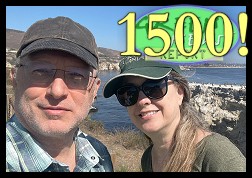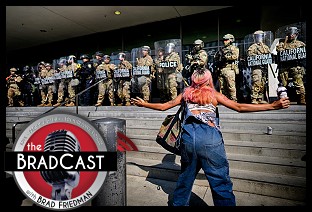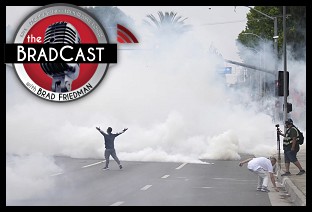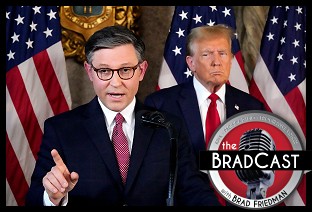 Guest blogged by Ernest A. Canning
Guest blogged by Ernest A. Canning
On Tuesday, a divided three judge panel of the U.S. 9th Circuit Court of Appeal ruled that California's Proposition 8 ban on same-sex marriage --- a right that had otherwise previously existed for same sex couples in the state --- violates the Equal Protection Clause of the 14th Amendment of the U.S. Constitution.
The majority opinion in Perry vs. Brown [PDF] this week decided an issue that was so narrow and so tightly crafted to meet the criteria of a 1996 U.S. Supreme Court decision, Romer v. Evans, that it minimized the chances that the U.S. Supreme Court will decide to hear the case, let alone reverse the decision.
As we examine the future course of the Prop 8 litigation, it's appropriate, if only briefly --- while this particular issue remains far away in the rear view mirror --- to offer a reminder of the still unresolved question as to whether CA voters actually approved the controversial measure at the ballot box in the first place...
Broader constitutional issues avoided
The 77-page majority opinion, which was written by veteran U.S. Circuit Judge Stephen Reinhardt (nominated by President Carter and confirmed in 1980) and joined by Judge Michael D. Hawkins (a former U.S. Marine Corps judge and former U.S. Attorney for AZ, who was nominated by President Clinton and confirmed in 1994), expressly declined to address the broader Constitutional issues of marriage equality, stating:
The narrowly crafted majority decision contains two aspects, which, when combined, suggest that Perry will have limited impact outside the boundaries of the Golden State.
First, per an earlier CA Supreme Court ruling, at the time voters went to the polls on Nov. 4, 2008, same-sex couples had a fundamental right to marry under the CA Constitution. Under the 2003 CA Domestic Partners Act both same-sex and opposite-sex unmarried couples who register as domestic partners have "the same rights, protections and benefits" and are "subject to the same responsibilities, obligations, and duties under law...as are granted to and imposed upon spouses."
Both before and after the adoption of Proposition 8, same-sex couples retained all rights incidental to marriage. This factor was critical in the majority's equal protection analysis. Proposition 8, Judge Reinhardt opined, "serves no purpose, and has no effect, other than to lessen the status of human dignity of gays and lesbians in California, and to officially reclassify their relationships and families as inferior to those of opposite-sex couples."
Narrow grounds may keep U.S. Supreme Court out
In "Proposition 8: What Happens Next?" this week, TPM's Jillian Rayfield reports on the view that the narrow scope of the Perry decision may have lessened the prospect that the U.S. Supreme Court would grant a hearing for the decision. She reports that view is shared by several law California law professors and by attorney David Boies, who, together with former Bush Administration Solicitor General Theodore Olson, argued Perry on behalf of the plaintiffs.
"The Court might not want to try to take this issue on those facts, and might wait for a case on a more general issue that the [9th Circuit] court did not have to face," Boies said during a conference call following announcement of the ruling.
However, as Rayfield went on to note, both Boies and Olson caution that because language utilized by Judge Reinhardt is language that would "support a national right to marriage equality," the Supreme Court might be tempted to hear the matter nonetheless.
If they did, it would entail going beyond the basis for the 9th Circuit decision, opening the way to criticism for an exercise in judicial activism --- the very type of judicial activism that provided a source of criticism in the now infamous Citizens United decision.
Narrow substantive ruling lessens likelihood of SCOTUS reversal
Both the majority, by evading the more pervasive issue, and the dissenting opinion, written by Judge N. Randy Smith, the former chair of the Idaho Republican party who was nominated by George W. Bush and confirmed in 2007, addressed the question of whether Proposition 8 violated the Equal Protection Clause of the U.S. Constitution's 14th Amendment by applying the lowest level of judicial scrutiny. Under this "minimal" scrutiny standard, a statute or ballot initiative should survive an Equal Protection challenge if there is a rational relationship to a legitimate governmental interest upon which it is based.
Judge Smith cited studies noting that "married biological parents" provide "the optimal parenting structure." He argued that this could "conceivably be a legitimate governmental interest." Smith suggested [emphasis added] that "the people of California might have believed that withdrawing from same-sex couples the right to access the designation of marriage would, arguably, further the interests in promoting responsible procreation and optimal parenting."
Judge Reinhardt made short work of those contentions, stating there was no need to examine "the sociological premise" embodied by the optimal parenting argument because "Proposition 8 had absolutely no effect on the ability of same-sex couples to become parents or the manner in which children are raised in California...Both before and after Proposition 8, committed opposite-sex couples ('spouses') and same-sex ('domestic partners') had identical rights with regard to forming families and raising children." Reinhardt added that "Proposition 8 did not alter the California adoption or presumed-parentage laws, which continue to apply equally to same-sex couples."
What Judge Smith, who conceded that it is not enough to simply posit "a conceivable governmental interest," has proffered is not a rational relationship to "a legitimate governmental interest" but, at best, an unfounded and speculative belief regarding a goal that has no rational connection to that which Proposition 8 accomplishes.
Supreme Court's 1996 Romer decision cited as binding precedent
Citing Romer as a controlling precedent, Judge Reinhardt wrote that the "People may not employ the initiative power to single out a disfavored group for unequal treatment and strip them, without a legitimate justification, of a right as important as the right to marry."
To understand Perry, one must first examine Romer.
In 1992 Colorado voters amended the Centennial State's constitution by way of a statewide referendum. The measure, known as Amendment 2, precluded all legislative, executive, or judicial action at any level of state or local government designed to protect the status of persons based on their "homosexual, lesbian or bisexual orientation, conduct, practices or relationships."
By a 6-3 margin (Chief Justice Rehnquist & Justices Scalia and Thomas dissenting), the U.S. Supreme Court ruled in the Romer case that Colorado's Amendment 2 violated the Equal Protection Clause of the 14th Amendment. The majority opinion was written by Justice Anthony Kennedy, who opined:
In his dissent in the Prop 8 case, Judge Smith sought to distinguish Romer because of the breadth of Amendment 2's across the board, discriminatory reach. Nonetheless, it seems doubtful that Justice Kennedy, who authored the Supreme Court's 2003 Lawrence v. Texas decision, which held that the Lone Star State's sodomy law violated the Due Process Clause of the 14th Amendment, will be persuaded by the differences highlighted by Smith.
To accept the argument, Kennedy would need to be convinced that the "indiscriminate imposition of inequalities" by eliminating a same-sex couple's previously state-recognized right to marry was more constitutionally permissible than the astoundingly broad range of discrimination embodied in Colorado's Amendment 2. Indeed, one would anticipate that Justice Kennedy would find Judge Reinhardt's majority reasoning more persuasive, to wit:
It is for these reasons that it is unlikely that the U.S. Supreme Court would reverse the 9th Circuit ruling in Perry.
'Was Prop 8 Straight'?
Finally, though this particular horse has likely long ago left the proverbial barn, it's worth a reminder at this point of one unfinished --- or rather, one completely unexamined question concerning Proposition 8's originally reported passage in California.
In this week's decision, all parties, the U.S. District Court and the 9th Circuit Court of Appeal, all made a basic assumption --- one embodied at the outset of Judge Reinhardt's opinion wherein he recited that on Nov. 4, 2008, "the People of California adopted Proposition 8, which amended the state constitution to eliminate the right of same-sex couples to marry."
As The BRAD BLOG reported back in January 2010, however, a 49-page study based on an 'Election Verification Exit Poll' raises still unresolved, serious doubts as to the accuracy of that basic assumption.
In that January 2010 article, Brad Friedman reported:
However, for Proposition 8 only, the official results varied from the Election Verification Exit Poll by an average of 7.75% in the 19 precincts polled. In some cases, the discrepancy was as high as 17.7%. That is, of course, far outside of the margin of expected error and certainly worthy of further investigation by officials.
Friedman went on to discuss the basic issue of our continued reliance upon "easily-hacked, oft-failed and non-transparent optical-scan paper ballot systems and computerized tabulators, rather than human beings who can oversee results as they are tabulated by hand."
He concluded:
Thus, it would perhaps have been useful if, before the CA Supreme Court and the U.S. 9th Circuit Court of Appeal recognized standing on the part of the proponents of Proposition 8 to represent the People of the State of California, they might have determined whether that measure actually received more "yes" votes than "no" votes. Sadly, however, the question was never made a part of the case. The failure of the government and corporate media to first address the fundamental questions about the reported passage of the measure (and others like it) have become all too often a matter of routine, with respect to serious election integrity issues that have arisen in literally thousands of articles published at The BRAD BLOG over the past eight years.
Ernest A. Canning has been an active member of the California state bar since 1977. Mr. Canning has received both undergraduate and graduate degrees in political science as well as a juris doctor. He is also a Vietnam vet (4th Infantry, Central Highlands 1968). Follow him on Twitter: @Cann4ing.


 Sunday 'Total Obliteration' Toons
Sunday 'Total Obliteration' Toons Thank You For Your Attention to This Matter:
Thank You For Your Attention to This Matter: 'Green News Report' 6/26/25
'Green News Report' 6/26/25
 Mamdani Primary 'Win' Augurs New Generation of Progressives Rising: 'BradCast' 6/25/25
Mamdani Primary 'Win' Augurs New Generation of Progressives Rising: 'BradCast' 6/25/25 U.S. Authoritarianism Under-way (But We're Still Here to Fight It): 'BradCast' 6/24/25
U.S. Authoritarianism Under-way (But We're Still Here to Fight It): 'BradCast' 6/24/25 'Green News Report' 6/24/25
'Green News Report' 6/24/25 'Anti-War' Trump Attacks a Mid-East Nation on False Claims About WMD: 'BradCast' 6/23/25
'Anti-War' Trump Attacks a Mid-East Nation on False Claims About WMD: 'BradCast' 6/23/25  Sunday 'Peacemaker' Toons
Sunday 'Peacemaker' Toons Senate Health Care Cuts 'More Extreme' Than House Version: 'BradCast' 6/19/25
Senate Health Care Cuts 'More Extreme' Than House Version: 'BradCast' 6/19/25 'Green News Report' 6/19/25
'Green News Report' 6/19/25 What 'Anti-War President'? MAGA Civil War Over Trump, Iran: 'BradCast' 6/18/25
What 'Anti-War President'? MAGA Civil War Over Trump, Iran: 'BradCast' 6/18/25 Trump Calls for 'Remigration', a Codeword for 'Ethnic Cleansing': 'BradCast' 6/17/25
Trump Calls for 'Remigration', a Codeword for 'Ethnic Cleansing': 'BradCast' 6/17/25 'Green News Report' 6/17/25
'Green News Report' 6/17/25 Last Weekend Today: 'BradCast' 6/16/25
Last Weekend Today: 'BradCast' 6/16/25 Sunday 'Despot Times, Despot Measures' Toons
Sunday 'Despot Times, Despot Measures' Toons Then They Came for the U.S. Senators: 'BradCast' 6/12/25
Then They Came for the U.S. Senators: 'BradCast' 6/12/25 'Green News Report' 6/12/25
'Green News Report' 6/12/25 Lawless Trump Warms Up for Insurrection Act: 'BradCast' 6/11/25
Lawless Trump Warms Up for Insurrection Act: 'BradCast' 6/11/25 Trump Inciting Violence, State of Fear in L.A., Elsewhere: 'BradCast' 6/10/25
Trump Inciting Violence, State of Fear in L.A., Elsewhere: 'BradCast' 6/10/25 Nevermind Elon and Epstein Files, Trump Declares L.A. 'Riots'!: 'BradCast' 6/9/25
Nevermind Elon and Epstein Files, Trump Declares L.A. 'Riots'!: 'BradCast' 6/9/25 'Jesus Weeps' at Trump's
'Jesus Weeps' at Trump's 300k 'Preventable' Deaths Since Trump USAID Shutdown: 'BradCast' 6/4/25
300k 'Preventable' Deaths Since Trump USAID Shutdown: 'BradCast' 6/4/25 Storm Warnings: 'BradCast' 6/3/25
Storm Warnings: 'BradCast' 6/3/25 SCOTUS Ignores Own Precedents In Recent 'Emergency' Rulings: 'BradCast' 6/2/25
SCOTUS Ignores Own Precedents In Recent 'Emergency' Rulings: 'BradCast' 6/2/25 'A World of Tyrants, Bribes, and Influence': 'BradCast' 5/22/25
'A World of Tyrants, Bribes, and Influence': 'BradCast' 5/22/25
 VA GOP VOTER REG FRAUDSTER OFF HOOK
VA GOP VOTER REG FRAUDSTER OFF HOOK Criminal GOP Voter Registration Fraud Probe Expanding in VA
Criminal GOP Voter Registration Fraud Probe Expanding in VA DOJ PROBE SOUGHT AFTER VA ARREST
DOJ PROBE SOUGHT AFTER VA ARREST Arrest in VA: GOP Voter Reg Scandal Widens
Arrest in VA: GOP Voter Reg Scandal Widens ALL TOGETHER: ROVE, SPROUL, KOCHS, RNC
ALL TOGETHER: ROVE, SPROUL, KOCHS, RNC LATimes: RNC's 'Fired' Sproul Working for Repubs in 'as Many as 30 States'
LATimes: RNC's 'Fired' Sproul Working for Repubs in 'as Many as 30 States' 'Fired' Sproul Group 'Cloned', Still Working for Republicans in At Least 10 States
'Fired' Sproul Group 'Cloned', Still Working for Republicans in At Least 10 States FINALLY: FOX ON GOP REG FRAUD SCANDAL
FINALLY: FOX ON GOP REG FRAUD SCANDAL COLORADO FOLLOWS FLORIDA WITH GOP CRIMINAL INVESTIGATION
COLORADO FOLLOWS FLORIDA WITH GOP CRIMINAL INVESTIGATION CRIMINAL PROBE LAUNCHED INTO GOP VOTER REGISTRATION FRAUD SCANDAL IN FL
CRIMINAL PROBE LAUNCHED INTO GOP VOTER REGISTRATION FRAUD SCANDAL IN FL Brad Breaks PA Photo ID & GOP Registration Fraud Scandal News on Hartmann TV
Brad Breaks PA Photo ID & GOP Registration Fraud Scandal News on Hartmann TV  CAUGHT ON TAPE: COORDINATED NATIONWIDE GOP VOTER REG SCAM
CAUGHT ON TAPE: COORDINATED NATIONWIDE GOP VOTER REG SCAM CRIMINAL ELECTION FRAUD COMPLAINT FILED AGAINST GOP 'FRAUD' FIRM
CRIMINAL ELECTION FRAUD COMPLAINT FILED AGAINST GOP 'FRAUD' FIRM RICK SCOTT GETS ROLLED IN GOP REGISTRATION FRAUD SCANDAL
RICK SCOTT GETS ROLLED IN GOP REGISTRATION FRAUD SCANDAL VIDEO: Brad Breaks GOP Reg Fraud Scandal on Hartmann TV
VIDEO: Brad Breaks GOP Reg Fraud Scandal on Hartmann TV RNC FIRES NATIONAL VOTER REGISTRATION FIRM FOR FRAUD
RNC FIRES NATIONAL VOTER REGISTRATION FIRM FOR FRAUD EXCLUSIVE: Intvw w/ FL Official Who First Discovered GOP Reg Fraud
EXCLUSIVE: Intvw w/ FL Official Who First Discovered GOP Reg Fraud GOP REGISTRATION FRAUD FOUND IN FL
GOP REGISTRATION FRAUD FOUND IN FL

































